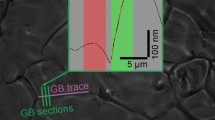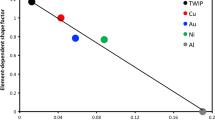Abstract
Grain-boundary stresses in copper for 60 symmetrical tilt grain boundaries with different orientations of the grain-boundary plane and tilt axis have been calculated by the molecular-statics method with the use of embedded-atom-method potentials of interatomic interaction. It has been established that the grain-boundary stresses are negative for grain boundaries with small excess volumes and increase approximately linearly with a buildup of the excess volume. It has been shown that the increase in grain-boundary stresses is connected with a decrease in the average coordination number of atoms, whereas pairs of closely spaced atoms in the grain-boundary core cause a negative contribution to grain-boundary stresses.
Similar content being viewed by others
References
H. Ibach, “The Role of Surface Stress in Reconstruction, Epitaxial Growth and Stabilization of Mesoscopic Structures,” Surf. Sci. Rep. 29, 193–263 (1997).
F. Spaepen, “Interface and Stress in Thin Films,” Acta Mater 48, 31–42 (2000).
Yu. R. Kolobov, Diffusion-Controlled Processes in Grain Boundaries and Plasticity of Metallic Materials (Nauka, Novosibirsk, 1998) [in Russian].
Yu. R. Kolobov, R. Z. Valiev, G. P. Grabovetskaya, et al., Grain Boundary Diffusion and Properties of Nanostructured Materials (Nauka, Novosibirsk, 2001) [in Russian].
B. Bokstein, M. Ivanov, Yu. Kolobov, and A. Ostovsky, “Grain Boundary Diffusion in Consolidated Nanomaterials. Stress Effect on Grain Boundary Diffusion,” in Nanodiffusion. Diffusion in Nanostructured Materials, Ed. by D. Beke, J. Metastab. Nanocryst. Mater. 19, 69–107 (2004).
R. Birringer, M. Hoffmann, and P. Zimmer, “Interface Stress in Polycrystalline Materials: The Case of Nanocrystalline Pd,” Phys. Rev. Lett. 88, 206104 (2002).
J. C. Hamilton, D. J. Siegel, I. Daruka, and F. Leonard, “Why Do Grain Boundaries Exhibit Finite Facet Length,” Phys. Rev. Lett. 90(24), 246102 (2003).
K. L. Merkle, “Atomic-Scale Grain Boundary Relaxation Modes in Metals and Ceramics,” Microscop. Microanal. 3, 339–351 (1997).
M. S. A. Daw and M. I. Baskes, “Embedded Atom Method: Derivation and Application to Impurities, Surfaces, and Other Defects in Metals,” Phys. Rev. B: Condens. Matter. 29(12), 6443–6453 (1984).
S. V. Eremeev, A. G. Lipnitskii, A. I. Potekaev, and E. V. Chulkov, “Vacancies on Low-Index Surfaces of Transition Metals and Aluminum,” Fiz. Tverd. Tela 39(8), 1386–1388 (1997).
S. V. Eremeev, A. G. Lipnitskii, A. I. Potekaev, and E. V. Chulkov, “Vacancies on the Surfaces of Transition Metals and Aluminum: Surfaces with High Indices,” Fiz. Met. Metalloved. 84(3), 77–81 (1997) [Phys. Met. Metallogr. 84, 251–255 (1997)].
A. Suzuki and Yu. Mishin, “Atomistic Modeling of Point Defects and Diffusion in Copper Grain Boundaries,” Interface Sci. 11, 131–148 (2003).
D. Wolf, “Correlation between the Energy and Structure of Grain Boundaries in BCC Metals. II: Symmetrical Tilt Boundaries,” Philos. Mag. A 62(4), 447–464 (1990).
M. S. Sorensen, Yu. Mishin, and A. F. Voter, “Diffusion Mechanism in Cu Boundaries,” Phys. Rev. B: Condens. Matter Mater. Phys. 62(6), 3658–3673 (2000).
Yu. Mishin, M. J. Mehl, D. A. Papaconstantopoulos, et al., “Structural Stability and Lattice Defects in Copper: Ab initio, Tight-Binding, and Embedded-Atom Calculations,” Phys. Rev. B: Condens. Matter Mater. Phys. 63, 224106 (2001).
G. J. Ackland and M. W. Finnis, “Semi-Empirical Calculation of Solid Surface Tensions in Body-Centered Cubic Transition Metals,” Philos. Mag. A 54(2), 301–315 (1986).
P. Gumbsch and M. S. Daw, “Interface Stresses and Their Effects on the Elastic Moduli of Metallic Multilayers,” Phys. Rev. B: Condens. Matter 44(8), 3934–3938 (1991).
P. Beurden and G. J. Kramer, “Parameterization of Modified Embedded-Atom-Method Potentials for Rh, Pd, Ir, and Pt Based on Density Functional Theory Calculations to Surface Properties,” Phys. Rev. B: Condens. Matter Mater. Phys. 63, 165106 (2001).
Author information
Authors and Affiliations
Additional information
Original Russian Text © A.G. Lipnitskii, A.V. Ivanov, Yu.R. Kolobov, 2006, published in Fizika Metallov i Metallovedenie, 2006, Vol. 101, No. 3, pp. 330–336.
Rights and permissions
About this article
Cite this article
Lipnitskii, A.G., Ivanov, A.V. & Kolobov, Y.R. Studying grain-boundary stresses in copper by the molecular-statics method. Phys. Metals Metallogr. 101, 303–308 (2006). https://doi.org/10.1134/S0031918X0603015X
Received:
Accepted:
Issue Date:
DOI: https://doi.org/10.1134/S0031918X0603015X




